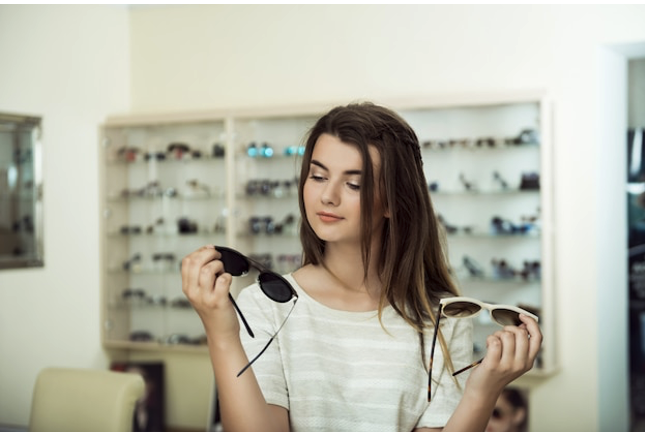
Sunglasses have become essential accessories for protection and style. As a result, more and more people have become aware of the importance of eye health as well as wanting to elevate their fashion game with a chic pair of frames.
The selection available is endless, as there are so many options to choose from. However, buying a pair of shades isn’t always straightforward for people who need vision correction. Glasses wearers may have to forgo UV protection for clear sight or keep their sunglasses on while dealing with blurriness. Contact lenses may help since they can be worn under the shades, but they aren’t ideal for everyone and may not be appropriate for certain activities. But with the growth of sunglasses, it’s now easier than ever to find a prescription pair, allowing you to enjoy clear vision, UV protection, and next-level style.
Top brands and retailers have made prescription sunglasses more accessible for wearers who need vision correction, which is a growing market due to the increase in eye issues. The popularity of outdoor activities and sports is also boosting demand, with the market for prescription sunglasses valued at $7.17 billion in 2024. If you’re one of the many looking for shades to keep you safe when you step outside, here’s how to pick the best prescription sunglasses:
Prescription sunglasses can make outdoor activities much safer and more comfortable without sacrificing your visual clarity. They can be a convenient option for hours spent under the sun since you can keep them on without switching between your glasses and regular shades. They’re also ideal if you don’t enjoy wearing contact lenses or if wearing them will be risky for certain activities like watersports and swimming. You also won’t need to keep track of any clip-on shades that can be easily misplaced or broken. Clear vision from your prescription, improved contrast, and less glare also help keep you safe when outdoors by enhancing your visibility.
If you haven’t had an eye exam in a long time, you may not have noticed any changes in your vision since then. Environmental conditions, lifestyle, profession, and more can affect your sight over time, so buying eyewear with an old prescription can cause issues like blurriness, eye fatigue, headaches, and more. Before you look for a pair of prescription sunglasses, schedule an appointment with your eye doctor to see if it needs an update. You might need a stronger prescription or correction for issues like astigmatism. You can also get a better idea of your vision changes and your eye health status. Discussing your lifestyle, the activities you do often, and your family history can give them a better idea of what you need for comfortable correction. Your doctor can also offer advice on finding the best prescription sunglasses, helping you make more informed decisions suited to your needs.

Your prescription will specify if you have nearsightedness, farsightedness, astigmatism, and more. While these are all important for ensuring your vision is appropriately corrected, measuring your pupillary distance can make your prescription sunglasses even more suited for your eyes. Your pupillary distance, the distance from the center of one pupil to the center of the other, indicates which part of the lens you should look at. This measurement is key to making your prescription sunglasses more comfortable; otherwise, it can cause eye strain, fatigue, or poor visual clarity if it isn’t right. Costa Del Mar’s tips on how to measure pupillary distance show that there are many ways to figure it out. You can ask your eye doctor to include it in your prescription, but if you don’t know it, you can also do it yourself. Apps like Opthy can measure it quickly, but you can use a manual approach. Measure your pupillary distance by looking at an object 20 feet away or a near object for near-sighted glasses and marking the center of your pupil using a felt tip marker on a pair of glasses or using a ruler and a mirror. Finding this distance can help you find prescription shades that line up perfectly with your eyes to avoid headaches and strain.
Once your prescription is updated and complete, you should focus on finding prescription sunglasses with excellent protective qualities. The main purpose of these shades is to protect your eyes from the sun’s harsh UV rays without compromising clear vision, as prolonged exposure can lead to long-term eye issues and conditions like macular degeneration or cataracts. Before anything else, look for a pair with 100% UVA and UVB protection. If you’re unsure how to verify that the sunglasses offer sufficient protection, buying them from trusted retailers and brands is best. Reputable names will be more transparent about UV blocking and the quality of their products. Buying from trusted retailers also makes adding your prescription to the lenses easier, whether online or in-store. Avoid buying frames that don’t indicate how much UV rays they block.

Prescription sunglasses come in a variety of models and frames that suit different activities. Considering your lifestyle and the activities you like to do can help you find a pair suited to your interests for the most comfortable experience. For instance, if you enjoy outdoor sports like cycling, a pair of prescription sports sunglasses like those from Oakley can keep your vision clear while optimizing your sports performance. They’re designed with athletes in mind, featuring durable materials, lightweight frames, and polarized lenses to block glare from reflective surfaces like water, snow, and metal. These keep you safe on the road, make the eyewear more comfortable, and enhance visual comfort and clarity. Regular sunglasses styles like Wayfarers or Aviators can suit more leisurely activities like running errands or sightseeing while traveling. Even driving can be something to consider; if you do a lot of daytime driving, prescription sunglasses with polarized lenses can also enhance visibility for safety.